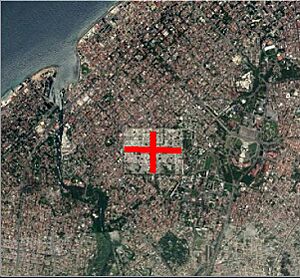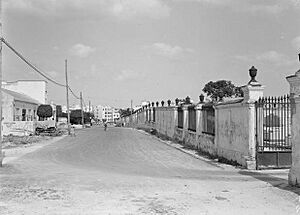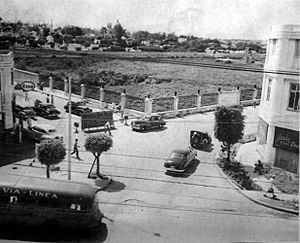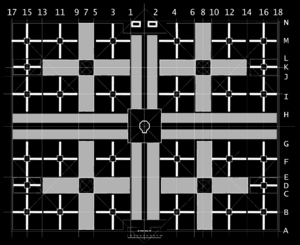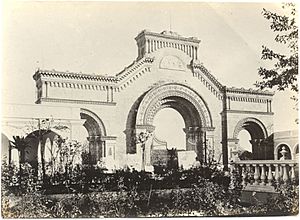Colon Cemetery, Havana facts for kids
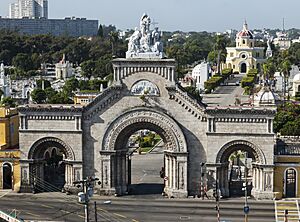
Main Gate
|
|
| Details | |
|---|---|
| Established | 1876 |
| Location |
Vedado, Havana
|
| Country | Cuba |
| Style | Classical |
| Owned by | Revolutionary government (contested) |
| Size | 49.57 hectares (122.5 acres) |
| No. of graves | 800,000 |
| No. of interments | over 1 million |
El Cementerio de Cristóbal Colón, also known as the Christopher Columbus Cemetery, is a famous burial ground in Havana, Cuba. It was started in 1876 in the Vedado area. The cemetery is named after the explorer Christopher Columbus.
It is well-known for its many beautiful and detailed memorials and sculptures. Experts believe there are over 500 large mausoleums here. Before this cemetery, people were buried in church crypts or at the older Espada Cemetery.
Contents
Exploring Colon Cemetery's History
The Colon Cemetery is considered one of the most important cemeteries in the world. It is especially significant in Latin America for its history and amazing architecture. Many people say it's second only to La Recoleta Cemetery in Buenos Aires.
Before Colon Cemetery opened, people in Havana were buried in church crypts. These were underground rooms in churches. Later, in 1806, the Espada Cemetery opened. However, after a serious illness outbreak in 1868, people realized they needed a much bigger place for burials. That's when planning for the Colon Cemetery began.
Art and Architecture in the Cemetery
The Colon Cemetery is a Catholic cemetery. It features many grand monuments, tombs, and statues created by artists from the 1800s and 1900s. Burial plots were often given out based on a family's social standing. Wealthy families used their tombs and mausoleums to show off their importance.
The main entrance on the north side is a large gateway. It has carvings from the Bible and a marble sculpture by José Vilalta Saavedra. This sculpture shows Faith, Hope, and Charity. Some of the most impressive tombs are found between this main gate and the central chapel.
Remembering Heroes: Firemen's Monument
One special monument is dedicated to firefighters. It's called the Monumento a los Bomberos (Firemen's Monument). Spanish sculptor Agustín Querol and architect Julio M Zapata built it. This monument honors 28 firefighters who died in a hardware shop fire in Old Havana in 1890.
In the center of the cemetery, where the main avenues meet, stands the octagonal Capilla Central (central chapel). It looks a bit like the famous Il Duomo in Florence. There's also the Capilla del Amor (Chapel of Love), built by Juan Pedro Baró for his wife.
The cemetery is laid out like a grid with streets leading in straight lines. It covers about 50 hectares (122.5 acres). Different areas are set aside for different groups of people. There are sections for priests, soldiers, wealthy families, and even infants.
Space and Preservation Challenges
With over 800,000 graves and more than 1 million burials, space in Colon Cemetery is limited. After three years, remains are often moved from their tombs. They are then placed in boxes and stored in a special building.
Despite its beauty, some parts of the cemetery show signs of age. Empty tombs and damaged family chapels can be seen, especially away from the main avenues. Many of these belong to families who left Cuba after the 1959 Revolution. This has made it hard for them to care for their family plots.
Designing a City for the Departed
The Colon Cemetery was designed by Calixto Arellano de Loira y Cardoso, an architect from Spain. Sadly, he became the first person buried there before his work was finished. The cemetery was built between 1871 and 1886 on what used to be farmland.
It's laid out like a city, with numbered and lettered streets. This makes it easy for visitors to find their way around. The cemetery features works by many famous Cuban artists from the 1800s and 1900s. These include Miguel Melero, José Vilalta de Saavedra, and Rene Portocarrero.
The design uses a pattern of five crosses formed by streets that cross each other. The two main avenues create a large central cross. Each of the four sections created by this cross is then divided again by other streets. The main intersection holds the Central Chapel.
The cemetery is mostly aligned north to south, parallel to the Almendares River. Its main streets point to the four main directions: north, south, east, and west. This design uses a symbol called a Greek cross. This cross represents the four directions of the earth.
The Grand Entrance Gate
Calixto Arellano de Loira y Cardoso also designed the impressive main entrance gate. It has a Romanesque style, which means it looks like ancient Roman architecture. The gate is over 21 meters (70 feet) high and 34 meters (112 feet) long.
It was finished by Eugenio Rayneri Sorrentino and topped with the sculpture "Faith, Hope and Charity" by José Vilalta Saavedra. The first stone for the gate was placed on October 30, 1871. However, burials had already started in the cemetery since 1868.
Notable People Buried Here
The Colon Cemetery is the final resting place for many important people from Cuba and beyond.
Honoring Athletes and Heroes
- Baseball Players: Since baseball is very popular in Cuba, the cemetery has two monuments for players from the Cuban League. These honor members of the Cuban Baseball Hall of Fame.
- USS Maine Sailors: In 1898, sailors who died on the United States Navy battleship Maine were first buried here. Later, their bodies were moved to the United States.
- Commonwealth War Graves: Three servicemen from the British Commonwealth are also buried here. They include a Canadian Army officer from World War I and a Royal Engineers officer and a Royal Canadian Navy seaman from World War II.
Famous Figures and Their Legacies
Many well-known individuals are buried in Colon Cemetery, including:
- Alicia Alonso (1920–2019), a world-famous ballet dancer.
- José Raúl Capablanca (1888–1942), a world chess champion, often called the "Mozart of chess."
- Carlos Finlay (1833–1915), a doctor and researcher who studied yellow fever.
- Ibrahim Ferrer (1927–2005), a famous Cuban singer.
- Máximo Gómez (1836–1905), a military hero from the Dominican Republic who fought for Cuba's independence.
- Nicolás Guillén (1902–1989), a celebrated Cuban poet.
- Alberto Korda (1928–2001), the photographer famous for the iconic image of Che Guevara.
- Dulce María Loynaz (1902–1997), a poet and novelist.
- Chano Pozo (1915–1948), a musician who helped create Afro-Cuban jazz.
|
See also
 In Spanish: Necrópolis de Cristóbal Colón para niños
In Spanish: Necrópolis de Cristóbal Colón para niños


